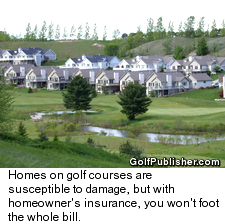- Alabama
- Arkansas
- Arizona
- California
- Colorado
- Connecticut
- Florida
- Georgia
- Illinois
- Indiana
- Michigan
- Missouri
- Montana
- Nevada
- New Mexico
- North Carolina
- Pennsylvania
- South Carolina
- Tennessee
- Texas
- Virginia
- Washington
- Wyoming
 REAL ESTATE
REAL ESTATE
Owners of golf course homes should take a second look at insurance
By Brandon Tucker,
Senior Writer
Each region of the United States poses its own unique threat to homeowners. In the South, hurricanes threaten coastal communities up to six months a year. Midwesterners must worry about tornados springing up at any time in the spring and summer and earthquakes are always just a rumble away on the west coast.
Golf course communities everywhere however have the added risk of: golfers.
Oddly enough, nearly half of all homeowners who live on a golf course don't play golf. So imagine their surprise when they realize that their home, sitting 200 yards on the right-hand side of a hole, gets pelted daily with little white bombs.
"I would not want to be on the right side of a par 4 about 180 yards down. You will get pelted with balls all day," said Dick Schaeffer, former vice president of marketing at Troon Golf Vacations.
"I would prefer to live on the left side of a par 3, but left side of a par 4 or 5 about 20 yards out of most golfers driving range is also ideal," said Schaeffer, who also notes that living behind tee boxes may be out of danger, but noise of foursomes on tee boxes can be inhibiting.
But what happens if your home happens to be in a common "slice zone"?
Homeowners insurance was introduced long before the rise of the golf community and was originally intended to cover natural disasters, thefts and accidents. Many also cover homeowners from injury liability should anything happen on their property.
Golfers, however, rarely assume responsibility for the errant shots, as it's difficult to find out exactly who broke the window without a confession or a witness. Also, in most cases, it's the homeowner responsible for repairing damage caused by errant shots.
Golf courses often shy away from paying for damages, although several lawsuits in the past have found courses to be guilty of negligence when dealing with houses that are hit an extraordinary amount of times. There's often confusion among homeowners who is responsible for damage to a house, but insuring your home can help clear it up.
"If you are golfing and breaks someone's window, the golfer is responsible," said Mike Siemienas, an All-State spokesman. "However, if no one claims responsibility or does a ‘hit-and-run', your homeowner's insurance will cover it."
Siemienas also points out that it depends on your deductible whether filing a claim is even worth it. Deductibles can range from $200 to $1,000 depending on your plan, which might cost more than the broken window itself.
Also, while it may seem more dangerous to live on a course, insurance companies don't view golf courses as more dangerous or susceptible to accidents than any other type of home, so you shouldn't have to pay a higher premium just because you live on a golf course.
If you are looking into purchasing a home in a golf community but are worried about safety, damage and privacy, there are certain measures you can take to minimize house damage.
Be sure to quiz your developer on materials used to build the home. Most golf course homes built in Arizona and Florida over the past 10 years are constructed with stucco and are particularly susceptible to damage from golf balls. Unfortunately, the majority of affordable golf course developments in the Southwest do not feature custom home options and buyers are limited in the construction materials they can choose from.
Also, windows should never be glass anywhere close to a golf course. Even on your windows that don't face the tee, install windows with shatter-proof material.
Once you've determined how susceptible to damage your house may be on your course after weighing the location and materials in, as well as how busy the course gets, then speak with insurance companies to see if their plan covers all your needs. If the community has a homeowner's association — most golf communities do — they likely know the local rules and what the homeowner is liable for.
September 11, 2006
Any opinions expressed above are those of the writer and do not necessarily represent the views of the management. The information in this story was accurate at the time of publication. All contact information, directions and prices should be confirmed directly with the golf course or resort before making reservations and/or travel plans.

